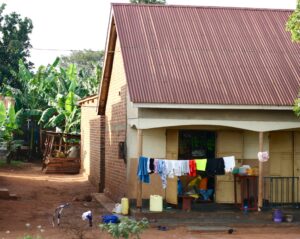Uganda: Housing Economic Value Chain and Housing Cost Benchmarking Analysis
Introduction:
This report focuses on Uganda’s housing market and housing economic value chain and consists of four important analytical components, form conclusions and recommendations are then derived. The first analytical component is Contextual Analysis of demographic and economic trends that speak to the scale of new household formation and where these households are located, relative trends in per capita incomes, and the comparative performance and contribution of the construction and real estate sectors of the Ugandan economy.

The second analytical component is a Housing Economic Value Chain developed for C AHF, which provides a macro analysis, that follows a methodology-level overview of the housing construction and housing rental value chains. The value chain analysis provides a link between micro rental production activities and the macroeconomy by in economic housing construction and housing between these activities and other sectors of the economy.
The theory of Housing Economic Value Chain:
An economic value chain describes the linkages and quantifies the economic value creation in an economy arising from a specific type of activity. Producing residential housing involves construction value-adding activities (digging and laying foundations, bricklaying, plastering carpentry, plumbing, electrical, tiling, roofing etc.), while housing rental incorporates real estate and a range of other value adding services.
The Housing Economic Value Chain (HEVC) describes the extent to which developers, contractors and households add value to the economy during the process of building, improving and renting houses through the addition of their intellectual property, management and skills (reflected in labour remuneration), payment of rents and interest, and generation of profits (collectively termed the gross operating surplus).
Data required to analyze Housing Economic Value Chain:
The ability to estimate these various impacts in any economy with some degree of accuracy depends largely on the accuracy and availability of relevant data. The linkages between the production of a particular product (such as a house) and other industries in an economy is usually captured in a supply and use table (SUT). While some countries have the necessary data to construct quite detailed SUTs, in other countries data availability is limited and/or quality is poor and SUTs have either not been constructed at all or exist only at a very high level with limited disaggregation into a range of products.
The Housing Construction Value Chain in Uganda:
Producing residential housing involves construction value-adding activities that are typically coordinated and undertaken by construction developers and contractors, who may be formal or informal entities. As indicated above, the growth in urban populations in Uganda and average household size suggests that the country will need to produce in excess of 160 000 dwelling units a year in urban areas – just to accommodate these new households -and more if the backlog that already exists in Uganda’s urban areas is to be reduced over time.
Economic activities arising from the letting of residential housing in Uganda:
The economic impact of the construction activity that arises when a house is built only lasts until the house is completed. By contrast, the activities associated with the renting of that house (assuming that it is not occupied by the owner) persist for the lifespan of the building – which will usually be a number of decades. As the stock of housing in an economy increases to accommodate a growing number of households, so the potential scale29 of economic activity associated with the renting of residential property also increases.
Housing affordability:
Having considered the household income distribution of Ugandan households in urban and rural areas, as well as the tenure conditions under which they currently occupy their accommodation, we now consider the affordability of these households for housing.
Housing supply:
Having established the affordability profile of Uganda’s households, we now look at the prevailing housing supply environment in Uganda. Historically, formal housing provision in urban Uganda was controlled by the public sector mainly through the National Housing Corporation.43 This is still evident through the 8 percent of urban households that still live in public rental housing.
Matching supply and demand:
The rapidly increasing urban growth of mostly lower to middle income households, when compared to the very limited and very expensive formal housing development outlined above in Uganda, results in a considerable mismatch between housing supply and housing demand. This raises three important issues for Uganda’s future housing approach.
Conclusion:
Uganda has the opportunity to create a more orderly response to the rapid urbanization it will face in the future. Uganda is still in an early stage of urbanization, with only a quarter of its population living in urban areas. Further, its current housing conditions indicate a reasonable balance between ownership and rental. This places Uganda in an important position to influence and better manage the projected rapid increase to urbanization it will face in the future.
Even though Uganda is in the early phases of urbanization, it is clear that significant challenges are blocking a more pro-active response to urban growth and development. Critically, land tenure uncertainties, planning constraints, a lack of land identification and servicing of land for housing development, a mismatch between housing supply and demand, and an under-developed housing finance market limit the extent to which pro-active responses can be implemented.
Also Read: Addressing the Affordable Housing Challenges for Urban Poor in Pakistan
